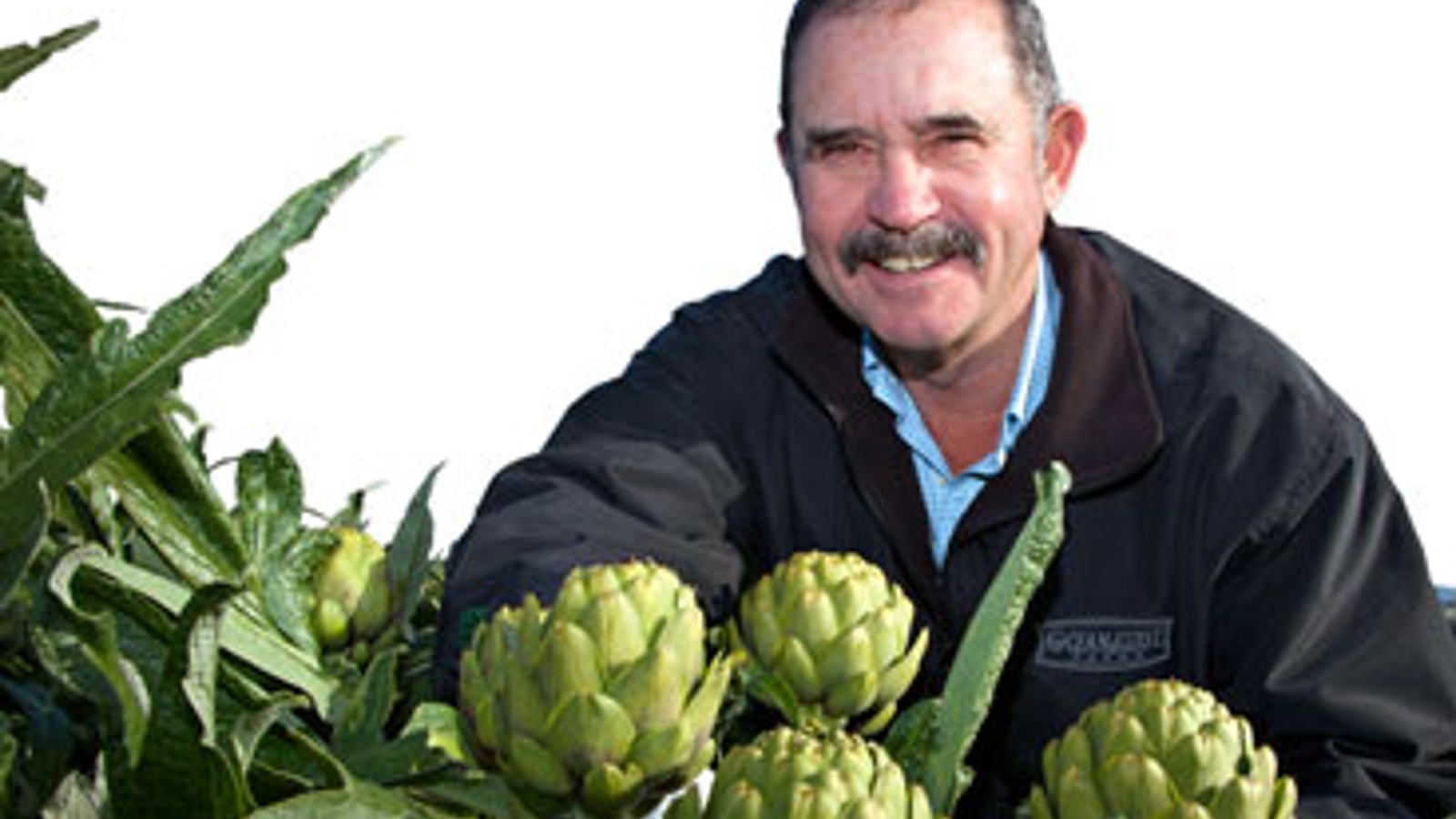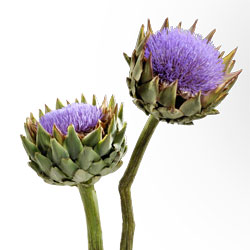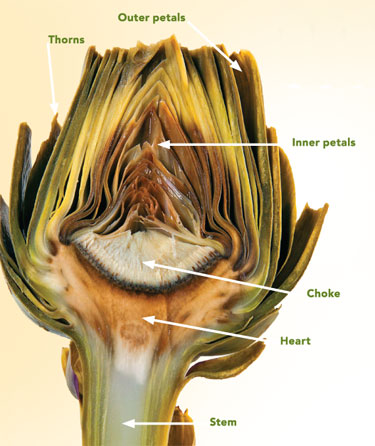Artichokes 101

![]() More online: All choked up: more info about artichokes
More online: All choked up: more info about artichokes

Meet the farmer
Dale Huss is probably the only person in the world with the job title "vice president of artichoke production." He oversees the crop for Castroville-based Ocean Mist Farms.
Is he the "Artichoke King?" Huss shrugs and laughs at the suggestion.
Artichokes can add a royal touch to a meal, he said, and pointed out that the artichoke is honored for its beauty and versatility as the official vegetable of Monterey County.
"It's a fun crop to grow," Huss said. "It's perfectly suited to the conditions in the Castroville area. And at this time of year—and this is absolutely true—you can stand in the fields and watch the artichokes grow. That's how fast it happens.
"It's like pushing racehorses into the starting gate and suddenly the gates are opened and you're off, galloping for harvest. I feel the tension building, feel the plants pushing the artichokes to maturity, and I have a sense of excitement about bringing this beautiful crop to market that's hard to contain."
Growing the globe

Artichokes are hand harvested in California nearly year-round. If allowed to flower, the buds develop into magnificant purple-blue blooms.
Although there are lots of artichoke varieties—Gros Camus, Violetto, Spinoso, Blanco—it's the green globe variety that American consumers find most often in the grocery store.
Artichokes, Cynara scolumus, are the buds of thistles that haven't blossomed. If the artichoke were permitted to bloom, it would make a purple-blue flower about 7 inches wide.
Experts at the University of California say the plant likes it cool for growing—75 degrees during the day, 55 degrees at night.
The artichoke plant can become quite large—3 to 4 feet tall with roots extending down 4 feet. One plant can produce more than 20 artichokes a year.
When all the artichokes are harvested from the perennial plant, it's cut to below the soil surface to encourage new shoots. A plant is good for five to 10 years of production.
Artichoke trivia:
Take the test
1. Where is the "Artichoke Center of the World"?
2. Who was the first artichoke queen?
3. How long—on average—does it take to eat an artichoke?
4. Who introduced artichokes to France?
5. Who introduced artichokes to California?
6. When was the first historical mention of artichokes?
7. Where did artichokes originate?
8. How many calories in an unadorned artichoke?
9. Where did the word artichoke come from?
10. What Italian liqueur is made with artichokes?
Answers
1. Castroville;
2. Marilyn Monroe in 1948;
3. 20 minutes;
4. Catherine de Medici, wife of French King Henry II;
5. Early Spanish settlers;
6. 40 to 70 AD, in the "Greek Herbal Dioscorides," a book on the medicinal uses of plants;
7. Mediterranean;
8. About 65;
9. Italian—articiocco and articoclos—which means pine cone;
10. Cynar, a bittersweet apéritif often mixed with orange juice.

FAQs
Just how good are artichokes?
Besides the delicious flavor, one medium-sized artichoke has about 65 calories per serving, more antioxidants than red wine or chocolate, and provides 20 percent of an adult's vitamin C requirement and 24 percent of the recommended amount of dietary fiber. It's high in potassium and magnesium, has 4 grams of protein and contains no fat.
When's the best time to buy?
Artichokes are available nearly year-round, although spring and summer are peak production times. About 99.9 percent of the U.S. supply comes from California. About two-thirds of the crop is produced in Monterey County.
Where do the artichoke hearts used in recipes come from?
Same place as the big boys. But they're "baby" artichokes—picked before the prickly inner "choke" develops.
How to's
How to buy
Look for large, hydrated, heavy globes with tight leaves and a deep green color. Check the stems for drying to avoid old or tough artichokes. In winter and early spring, bronze-tipped artichokes show the effects of cold temperatures, which experts say indicates tender leaves inside and a rich, nutty flavor.
How to cook
There are about as many ways to cook an artichoke as there are cooks to do the job. Whether it's one or a dozen, give the prickly heads a quick scrub, snip the thorns with kitchen shears, trim the ends with a sharp knife and plump the leaves.
Some cooks like to give artichokes a lemon rub for flavor and to prevent browning. Plop them into a pot of boiling water or try steaming, sautéing, baking, grilling or microwaving. To test for doneness, pierce the stem to check for tenderness or pull inner leaves to check for easy release.
Cooking artichokes is a free-style event, so when in doubt, consult with the artichoke authorities first: www.artichokes.org or www.oceanmist.com.
How to store
Uncooked artichokes can remain fresh for about a week when properly stored. Sprinkle with water, place in an airtight plastic bag and refrigerate.
How to eat
The artichoke is the original finger food: Eat by hand, one leaf at a time. Dip leaves into provided sauce. Grip the leaf lightly between the front teeth and pull gently, scraping off the leaf's soft flesh side. Put the spent leaf to the side of the plate.
Once the leaves have been peeled away, the thistle's fuzzy center (choke) is exposed. Holding the base of the artichoke, use a knife or spoon to circle the base's rim and scoop out the concave, fuzzy center and add to the pile of discarded leaves. Cut the remaining heart into bite-sized pieces, using a fork and knife, and dip into the sauce reserved on the plate.
Order 'em fresh from the farm
The Lazzarini and Pezzini families have been growing and selling artichokes in California for generations and now offer fresh artichokes and a variety of artichoke-related products on their websites.
Lazzarini: www.BuyArtichokes.com
Pezzini: www.pezzinifarms.com

Poster art from 2009 Artichoke Festival
Mark your calendar
Plan ahead to "rock the choke" next year at the Castroville Artichoke Festival, May 18 and 19, for music, art, food, wine tasting, a parade, kids' activities, street performers and farmers market. While there, don't forget to hop a shuttle to the artichoke patch for grower talks and photo ops: www.artichoke-festival.org.
All choked up: more info about artichokes
There's lots to know about California's favorite thistle. Here are a few more facts (and maybe one fiction!).
Artichoke wars? Apparently
Here's how the story goes: In the 1920s, Ciro Terranova (1889-1938), a member of the Mafia known as the "Artichoke King," monopolized the eastern artichoke market by buying all the artichokes shipped from California to New York. He resold them at 30 percent to 40 percent profit. Not only did he terrorize East Coast distributors and produce merchants by forcing them to buy high-priced chokes, he even launched an attack on California's artichoke fields, sending thugs to chop down plants in the dark of night to help keep prices up.
These "artichoke wars" led then-New York Mayor Fiorello La Guardia to ban "the sale, display and possession" of artichokes in New York. In the thick of battle, the mayor publicly acknowledged he himself loved the stickery vegetable. After only a week, he lifted the ban.
Is a Jerusalem artichoke a real artichoke?
Not really. Jerusalem artichokes are the tuberous roots of a kind of sunflower. They're also called "sunchokes" and were cultivated by Native Americans long before the arrival of Europeans.
Artichoke Aficionado Club
Based in Castroville, Ocean Mist is the largest grower of fresh artichokes in the United States and grows them year-round in three ideal artichoke-growing areas of California: Castroville, Oxnard and Coachella.
The growers of Ocean Mist offer artichoke aficionados a weekly chance at winning a carton of fresh artichokes. For details: www.oceanmist.com/aficionados/subscribe.aspx
Choke chuckle
"Artichoke? It's a good food. You eat, you drink, you wash your face."
— Enrico Caruso, Italian opera singer

